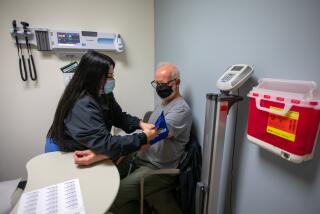Online house calls click with doctors
- Share via
Consulting your family physician is finally moving into the 21st century and out of the doctor’s office.
Since the dawn of e-mail, patients have been pleading for more doctors to offer medical advice online. No traffic jams, no long waits, no germ-infested offices with outdated magazines and bad elevator music.
There was always one major roadblock: Most health insurers wouldn’t pay for it.
Until now.
In recent weeks, Aetna Inc., the nation’s largest insurer, and Cigna Corp. have agreed to reimburse doctors for online visits. Other large insurers are expected to follow, experts say.
These new online services, which typically cost the same as a regular office visit, are aimed primarily at those who already have a doctor.
The virtual visits are considered best for follow-up consultations and treatment for minor ailments such as colds and sore throats.
But some specialists, including cardiologists and gynecologists, also see these e-mail tete-a-tetes as ideal for periodic checkups that don’t require in-person visits.
“People can wait a long time to get in to see their primary-care doctor and longer for a specialist. . . . To have immediate access is huge,” said Dr. Melissa Welch, Aetna’s Northern California medical director.
As more doctors move online, others are looking further ahead and adding webcams to their online arsenal, even if the video quality remains spotty.
Dr. Christy Calderon, a family physician at Kaiser Permanente’s Whittier office, conducts as many as half her appointments over the phone or online with a 3-inch camera affixed to her desktop. “It adds a more personal touch,” she said.
Although actual doctor visits aren’t likely to disappear, the recent moves are evidence that long-delayed efforts to bring American medicine into the digital age may be gaining momentum, experts say.
“Paying doctors to do more patient care over the Internet is a small but important step in a good direction,” said David Cutler, a Harvard University healthcare economist. “It increases patient access and could significantly improve their satisfaction.”
If so, it comes at an auspicious time.
Doctor visits in the United States have surged 20% in the last five years to more than 1.2 billion visits annually, according to the Centers for Disease Control and Prevention. Even as the population ages, the number of doctors is falling across the country, and experts predict that office wait times will increase in the coming years.
Meanwhile, at-home devices that remotely check patients’ blood pressure and diabetics’ sugar levels are becoming cheaper, and tech leaders Google Inc. and Microsoft Corp. are expected to introduce products this year to simplify patient care and put medical records online, although neither company plans to assist in online physician appointments.
Some in the medical community envision a day when patients take their vital signs each morning and send the results to their doctor by computer.
But can a doctor really diagnose patients via pixels?
Critics, including many doctors, contend that online medical care carries risks. Some worry that mistakes are bound to happen and that the practice raises several hard-to-answer ethical questions.
“It’s perfectly appropriate that we use 21st century technology in the 21st century,” said California Medical Assn. President Dr. Richard S. Frankenstein, an Orange County pulmonologist. “The concern I have is that [online visits] are simply not a substitute for an actual doctor.”
And experts caution that this may not be a money saver. Healthcare costs could increase if the new technology leads more patients to seek care more often.
By the time San Francisco consultant Meg Young got to Boston on a chilly night last winter, she was running a 102-degree fever. She considered going to the emergency room. Instead, she went online in her hotel room.
The 40-year-old technology expert booked a visit with her primary-care doctor at Stanford University Hospital. After Young filled out a form and described her symptoms, he diagnosed a bacterial infection, prescribed an antibiotic from a drugstore near the hotel and suggested she get some rest.
“I couldn’t have been happier to not sit in some hospital for half the night,” Young said.
Doctors and patients have many ways to communicate over the Internet. Some doctors and their office staffers already e-mail patients free of charge, especially when it involves minor questions or prescription refills.
Most of the new online consultations are far more structured than a simple e-mail. If insurance companies are expected to pay the bill, physicians need documentation of the event, including diagnosis and time spent.
As a result, companies have emerged to help doctors handle this. They typically arrange the online visits, maintain records and handle insurance reimbursements, patient co-payments and other payments.
To begin using these online services, patients visit a doctor’s website or go directly to one of the Internet companies that handle such services -- for example, RelayHealth Inc. or Medem Inc.
Doctors are typically encouraged to respond to patients within a day; they receive an e-mail reminder if they haven’t, with a phone call on the second day. Prices can vary from $25 to $125, which patients pay with a credit card at the end of the session.
Allison Holt, 47, of Santa Ana said she was “completely sold” on online healthcare and didn’t plan to visit her doctor in person anymore if she could help it.
The former human resources manager began using online appointments in May, after a long-simmering back problem flared up.
Holt has had two full check-ups since then and occasionally e-mails her doctor with minor questions or to request a prescription refill.
The visits cost $25 and are not covered by her insurance.
“When I used to call his office, the staff would take a message, wait for a reply and then call me back when they had time,” she said. “Now I get an e-mail by the end of the day.”
Even with major insurers signing on, it remains to be seen whether a large share of the public will embrace Internet medicine. Surveys show that many patients and doctors remain uncertain whether the technology is right for them. Also still on the sidelines is the federal Medicare agency, which pays about half the nation’s doctor bills.
Recently, some smaller insurers that began reimbursing for online consultations stopped doing so because few members used the service.
But Young, the San Francisco technology consultant, predicts that routine doctor visits will eventually go the way of the locomotive or buying CDs at the store.
“It can take me an hour and 15 minutes to drive to my doctor’s office, longer in rush hour,” she said. “Why do I want to do that?”
--
(BEGIN TEXT OF INFOBOX)
Saying ‘Ah’ online
Top 10 topics in Internet physician consultations handled through RelayHealth, a provider of online physician services.
1. Medication questions
2. Sinus pain or pressure
3. Back problems
4. Colds and flu
5. Lab or test results
6. Coughing
7. Medical procedure or operation
8. Headaches and migraines
9. Fever
10. Asthma
Source: RelayHealth
More to Read
Inside the business of entertainment
The Wide Shot brings you news, analysis and insights on everything from streaming wars to production — and what it all means for the future.
You may occasionally receive promotional content from the Los Angeles Times.










